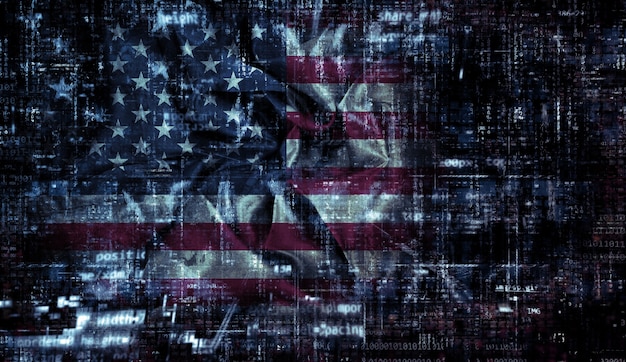How Will the US Combat State-Sponsored Cyber Warfare?

The United States will likely employ a multifaceted approach, combining defensive cyber capabilities, offensive strategies, international partnerships, and economic sanctions, to counter the escalating threat of cyber warfare from state-sponsored actors.
The digital battlefield is no longer a futuristic concept; it’s a present-day reality. As state-sponsored actors increasingly leverage cyber warfare to achieve their geopolitical objectives, the vital question arises: How Will the US Respond to the Growing Threat of Cyber Warfare from State-Sponsored Actors?
Understanding the Landscape of Cyber Warfare
Cyber warfare is no longer a theoretical threat; it is a tangible and escalating reality. This section explores the current state of cyber warfare, focusing on the key players, common tactics, and the geopolitical context that fuels these digital conflicts.
The Rise of State-Sponsored Cyber Actors
Several nations have developed sophisticated cyber warfare capabilities, often employing them to pursue strategic objectives. These actors engage in espionage, sabotage, and disinformation campaigns, blurring the lines between traditional warfare and digital conflict.
- Russia: Known for its aggressive cyber operations, including interference in foreign elections and attacks on critical infrastructure.
- China: Focuses on economic espionage and intellectual property theft, targeting key industries and government agencies.
- Iran: Increasingly active in cyber warfare, often targeting US and allied interests in response to geopolitical tensions.
- North Korea: Utilizes cyberattacks for financial gain and to disrupt adversaries’ operations.
Common Tactics and Strategies
State-sponsored cyber actors employ a diverse range of tactics, often adapting their strategies to exploit vulnerabilities and evade detection. Understanding these methods is crucial for effective defense.

Here are some strategies:
- Phishing: Deceptive emails and messages designed to steal credentials and gain access to networks.
- Malware: Viruses, worms, and other malicious software used to disrupt systems and steal data.
- Ransomware: Encrypting data and demanding payment for its release, often targeting critical infrastructure.
- Distributed Denial of Service (DDoS) attacks: Overwhelming systems with traffic to disrupt services.
Cyber warfare is characterized by its asymmetry, where actors with limited resources can inflict significant damage on powerful nations. This dynamic requires a proactive and adaptive defense strategy.
Strengthening US Cyber Defenses
A resilient defense is the cornerstone of any effective cyber strategy. This section delves into the measures the US is taking to bolster its cyber defenses and protect critical infrastructure from state-sponsored attacks.
Cybersecurity Infrastructure and Programs
The US government has established several agencies and programs to enhance cybersecurity, including the Cybersecurity and Infrastructure Security Agency (CISA) and the Department of Homeland Security (DHS). CISA plays a central role in coordinating cyber defense efforts across federal agencies and the private sector.
Investment in cutting-edge technologies such as artificial intelligence (AI) and machine learning (ML) is crucial. These technologies can automate threat detection, improve incident response times, and enhance overall network security.
Public-Private Partnerships
Cyber defense is a shared responsibility, requiring close collaboration between the public and private sectors. Critical infrastructure is largely owned and operated by private companies, so their participation is essential for effective defense.
Information sharing initiatives enable government agencies and private companies to exchange threat intelligence, best practices, and incident response strategies. This collaborative approach enhances situational awareness and improves the ability to detect and respond to attacks.
Enhancing Cybersecurity Awareness and Training
Human error is a major vulnerability in cybersecurity. Comprehensive cybersecurity awareness and training programs are essential to educate employees about phishing, malware, and other common threats.
Regular training exercises and simulations can help organizations identify weaknesses in their defenses and improve their response capabilities. Investment in cybersecurity education for the workforce is a critical component of a robust defense strategy.
By prioritizing cybersecurity and fostering a culture of vigilance, the US can significantly reduce its vulnerability to state-sponsored cyberattacks.
Offensive Cyber Capabilities and Deterrence
While a strong defense is essential, it is not sufficient to deter state-sponsored cyberattacks. This section examines the role of offensive cyber capabilities in deterring adversaries and responding to attacks.
Developing Offensive Cyber Weapons
Offensive cyber capabilities can be used to disrupt adversaries’ operations, deter aggression, and impose costs for malicious behavior. The US has developed sophisticated cyber weapons and strategies to counter state-sponsored attacks.
However, the use of offensive cyber capabilities raises complex legal and ethical questions. Clear guidelines and oversight mechanisms are necessary to ensure that these capabilities are used responsibly and in accordance with international law.

Deterrence Strategies and Policies
Deterrence is a key component of US cyber strategy. Clear and credible threats of retaliation can discourage adversaries from launching cyberattacks. The US has adopted a policy of “defend forward,” which involves proactively disrupting adversaries’ cyber operations before they can cause harm.
Diplomatic efforts to establish international norms for cyber behavior are also essential. By working with allies to define acceptable and unacceptable actions in cyberspace, the US can help create a more stable and predictable environment.
A combination of strong defenses, offensive capabilities, and diplomatic efforts is necessary to deter state-sponsored cyberattacks and protect US interests in cyberspace.
International Cooperation and Alliances
Cyber warfare is a global challenge that requires international cooperation and alliances. This section explores the importance of working with allies to counter state-sponsored cyber threats.
Building Alliances for Cyber Defense
The US has forged alliances with key partners to enhance cyber defense and share threat intelligence. These alliances enable countries to pool resources, share best practices, and coordinate responses to cyberattacks.
Multilateral initiatives such as the Budapest Convention on Cybercrime provide a legal framework for international cooperation in combating cybercrime. The US actively participates in these initiatives to strengthen global cybersecurity.
Sharing Threat Intelligence and Best Practices
Sharing threat intelligence is essential for effective cyber defense. The US works with allies to exchange information about emerging threats, attack patterns, and vulnerabilities.
Collaborative exercises and training programs enable countries to improve their cyber defense capabilities and coordinate responses to large-scale attacks. These efforts contribute to a more secure and resilient global cyberspace.
By working together with allies, the US can amplify its cyber defense capabilities and deter state-sponsored attacks more effectively.
Economic Sanctions and Diplomatic Pressure
Economic sanctions and diplomatic pressure can be powerful tools for deterring state-sponsored cyberattacks. This section examines how the US uses these tools to hold adversaries accountable for malicious cyber behavior.
Imposing Costs on Cyber Aggressors
The US has imposed economic sanctions on individuals and organizations involved in state-sponsored cyberattacks. These sanctions can freeze assets, restrict travel, and prohibit business dealings, imposing significant costs on cyber aggressors.
Publicly attributing cyberattacks to specific state actors can also deter future aggression. This tactic shines a spotlight on malicious behavior and increases the reputational costs for those involved.
Leveraging Diplomatic Channels
Diplomatic channels can be used to raise concerns about state-sponsored cyberattacks and seek commitments to responsible behavior in cyberspace. The US engages in bilateral and multilateral discussions to address cyber threats and promote international norms.
Working with international organizations such as the United Nations can help build consensus on cyber issues and develop coordinated responses to cyberattacks. Diplomatic pressure can complement economic sanctions and contribute to a more stable and secure cyberspace.
By combining economic sanctions and diplomatic pressure, the US can send a clear message that malicious cyber behavior will not be tolerated.
The Future of US Cyber Strategy
The threat of state-sponsored cyber warfare is constantly evolving, requiring the US to adapt its cyber strategy to meet emerging challenges. This section looks at the future of US cyber strategy and the key trends that will shape it.
Adapting to Emerging Technologies
Emerging technologies such as artificial intelligence, quantum computing, and the Internet of Things (IoT) will have a profound impact on cyber warfare. The US must invest in research and development to stay ahead of adversaries in these areas.
AI can be used to automate threat detection, improve incident response, and develop more sophisticated cyber weapons. Quantum computing could potentially break existing encryption algorithms, posing a significant threat to cybersecurity.
Preparing for Future Cyber Threats
The US must prepare for future cyber threats by investing in resilience, redundancy, and advanced threat detection capabilities. This includes developing strategies to protect critical infrastructure, secure supply chains, and defend against disinformation campaigns.
Continuous improvement and adaptation are essential for maintaining a strong cyber posture in the face of evolving threats. The US must remain vigilant and proactive to protect its interests in cyberspace.
By anticipating future trends and investing in innovation, the US can ensure that it remains a leader in cyber defense and deterrence.
| Key Point | Brief Description |
|---|---|
| 🛡️ Strengthening Defenses | Enhancing infrastructure, programs, and public-private partnerships. |
| ⚔️ Offensive Capabilities | Developing cyber weapons and deterrence strategies. |
| 🤝 International Cooperation | Building alliances and sharing threat intelligence. |
| 💰 Economic Sanctions | Imposing costs and leveraging diplomatic channels. |
FAQ
▼
State-sponsored cyber warfare involves cyberattacks carried out by or with the support of a nation-state, often targeting critical infrastructure, government systems, or private sector entities.
▼
These attacks seek espionage, sabotage, disruption, or theft of intellectual property, all to advance geopolitical or economic interests of the sponsoring state.
▼
The U.S. employs a multi-layered approach, including cybersecurity programs, public-private partnerships, law enforcement, and international collaboration to ensure protection.
▼
These alliances enhance cyber defense by sharing threat intelligence, coordinating defenses, and setting global standards for cyberspace behavior.
▼
The future strategy focuses on adapting to new technologies, enhancing threat detection, fostering global cooperation, and maintaining a resilient cyber infrastructure in an ever-evolving digital landscape.
Conclusion
In conclusion, addressing the escalating threat of cyber warfare from state-sponsored actors requires a comprehensive and adaptive strategy. By strengthening defenses, developing offensive capabilities, fostering international cooperation, and leveraging economic and diplomatic tools, the US can deter attacks, protect its interests, and promote a more secure and stable cyberspace.





